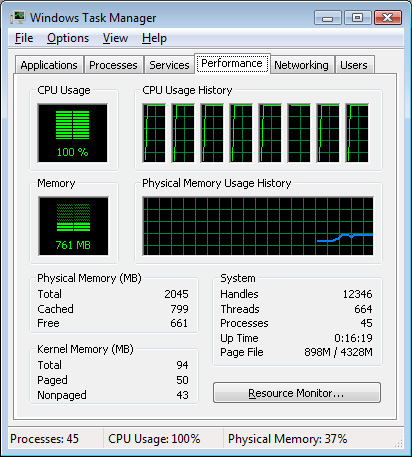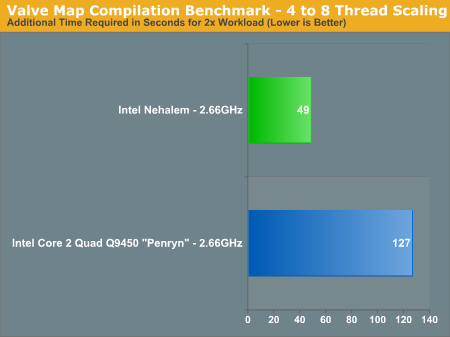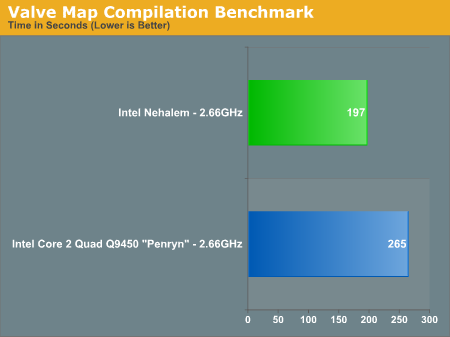The Nehalem Preview: Intel Does It Again
by Anand Lal Shimpi on June 5, 2008 12:05 AM EST- Posted in
- CPUs
The Return of Hyper Threading
While Nehalem is designed to scale to up to 8 cores per chip, each one of those cores has the hardware necessary to execute two threads simultaneously - yep, it's the return of Hyper Threading. Thus our quad-core Nehalem sample appeared as 8 logical cores under Windows Vista:

Four cores, eight threads, all in a desktop CPU
Note that as in previous implementations of Hyper Threading (or other SMT processors) this isn't a doubling of execution resources, it's simply allowing two instruction threads to make their way down the pipeline at the same time to make better use of idle execution units. Having 8 physical cores will obviously be faster, but 8 logical (4 physical) is a highly power efficient way of increasing performance.
We took Valve's source-engine map compilation benchmark and measured the compile time to execute one instance (4 threads) vs. two instances of the benchmark. The graph below shows the increase in compilation time when we double the workload:

While the 2.66GHz Core 2 Quad Q9450 (Penryn) takes another 127 seconds to execute twice the workload, the 2.66GHz Nehalem only needs another 49 seconds. And if you're curious, this quad-core Nehalem running at 2.66GHz is within 20% of the performance of an eight-core 3.2GHz Skulltrail system. Equalize clock speed and we'd bet that a quad-core Nehalem would be the same speed as an 8-core Skulltrail here. The raw performance numbers are below:

We couldn't disable Hyper Threading so we reached the limits of what we were able to investigate here.










108 Comments
View All Comments
kilkennycat - Thursday, June 5, 2008 - link
Isn't 6GB of RAM a pretty sweet spot for desktop 64-bit applications, whatever about servers?jimmysmitty - Thursday, June 5, 2008 - link
Well I have been waiting for Nehalem. I gave in and decided to build a rig with the Q6600 but kinda sad now.Anwways. Crank the Planet, hes not showing fanboyism. He stated Intel has been promising 20-30% increase with Nehalem. They are seeing 20-50% from these benchmarks. Take 21 and divide it by 14 that gives you 1.5. That means that the AMD Phenoms latency is about 50% slower.
If anything you are showing fanboyism. Nehalem is showing to be one hell of a chip and you are just angry that AMD has nothing to compare to it. Even after AMD finishes absorbing ATI whats next, K10.5 aka Deneb? Thats just a 45nm refresh (just like Penryn was for Conroe). Unless there are some major changes in the architecture it will just, hopefully, make Phenom run at higher clocks and cooler.
Other than that I can't wait to see what this does for games. I know that most games are more GPU dependant but I myself play mainly Valve games using Source and thats very CPU dependant and already runs great on my Q6600 but I want to see what this game will do for their particle and physics system...
Nehemoth - Thursday, June 5, 2008 - link
Please, Please, Please Intel I would to have this monsters chip in our servers without the annoying FBD, I don't want hoty FBD bring me normal DDR2 (without FBD) or DDR3.Just what I ask.
Griswold - Thursday, June 5, 2008 - link
I'm a big fan of multi-core systems, but I'm not blind to reality: Why no single threaded benchmarks, but only benchmarks that scale very good with more cores/SMT? By the time these things will be on the market, most applikations will still be single threaded and you know it...I just want to know how much faster it is per clock per core.
Anand Lal Shimpi - Thursday, June 5, 2008 - link
Interestingly enough, none of our standard CPU benchmarks are single threaded at all - even the most benign ones are multithreaded (including the games). I did run some single thread Cinebench numbers though:Nehalem - 3015
Q9450 - 2396
bradley - Thursday, June 5, 2008 - link
Why is there such a large discrepancy between previous single-threaded Cinebench tests from six months ago: where the Q9450 scored a 2944, or a mere 2.4% decrease, compared to the current 2396, or a more substantial 20.5% decrease.http://www.anandtech.com/printarticle.aspx?i=3153">http://www.anandtech.com/printarticle.aspx?i=3153
I too believe single-threaded benches should be the foundation of any meaningful and relevant cpu review, if time indeed was permitting. To me this is the greatest objective real-world equalizer. There just isn't enough multi-threaded software out there, much less software able to run all eight cores. I would also like to emphasize that unlike server chips, desktop Nehalems will only have two memory channels. And as I understand, hyper threading also will only make an appearance in server and enthusiast chipsets. So already this makes an accurate comparison difficult enough.
Finally, I understand the avg visitor will treat this like any good entertainment, where one is meant to suspend his-her disbelief. Still I have a hard time believing anyone has the ability to abscond away such important chips from a huge corporation like Intel. "Without Intel's approval, supervision, blessing or even desire - we went ahead and snagged us a Nehalem (actually, two) and spent some time with them." That initial premise does make anything coming after less impactful, or seemingly less than straightforward.
Certainly if history has taught us anything, we know final shipping silicon is sometimes quite different from test chips. We should also assume it's a lot easier to create ond one chip than manufacture hundreds of thousands on a large scale. Nothing is ever a given, which makes it hard to draw much of a conclusion. Interesting preview nonetheless.
SiliconDoc - Monday, July 28, 2008 - link
Shhhhh... gosh we have to have core hype ... and the multicore testers have to optimize for the coming chips... geeze they have to make a living somehow...( You sir, are exactly correct, but we live in a strange world nowadays where the truth is so evident it must be hidden most of the time for various other reasons... )
Gosh, you want to crash the whole economy with that sane and rational talk ?
What are you an anarchist ? ( yes I'm kidding, that was a big high five to you)
Anand Lal Shimpi - Thursday, June 5, 2008 - link
Ignore those numbers (check page 6 of the comments for an explanation), the Q9450 comes in at 2931 vs. Nehalem's 3015.-A
pnyffeler - Thursday, June 5, 2008 - link
I'm not a Mac person, but I think Mac's may benefit from this technology even more than Vista. As I recall from a previous Anandtech article, Mac's have an excellent memory management system, which very direct benefit in increasing memory size. The increased bandwidth could make the snazzy OS even better...Visual - Thursday, June 5, 2008 - link
It is great that your "clock for clock" comparisons to the penryn in encoding and rendering are showing an improvement... but could that improvement be from the doubled amount of virtual processors that are visible? Are all of these benchmarks using eight or four threads on the nehalem?